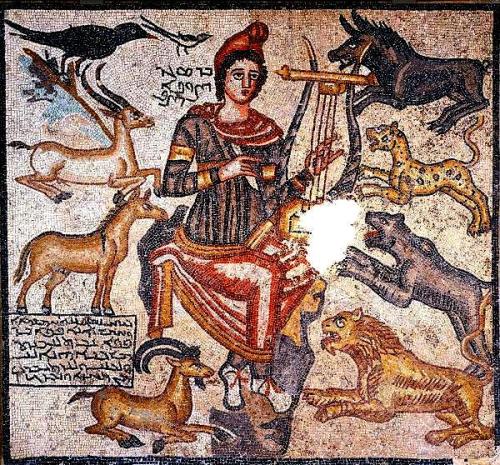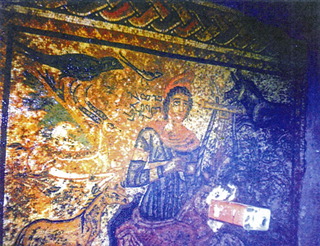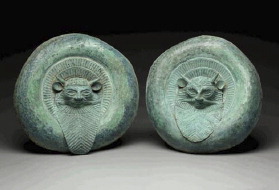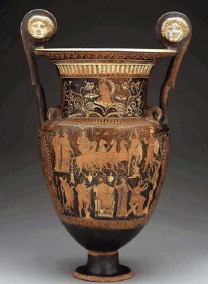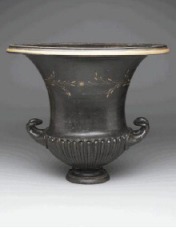Happy New Year from Chasing Aphrodite.
It’s been a year and a half since our book was published, and during that time the hunt for looted antiquities at the world’s museums has gone global. Over the past 12 months we’ve revealed new information about objects looted from Turkey, Cambodia, India, Latin America, Italy and beyond. Visitors from 150 different countries came to read our weekly posts. (Those interested in a daily feed of relevant links and commentary should like us on Facebook or follow us on Twitter.) Our focus here is on scoops, and over the past year we broke several significant stories about the illicit trade, some of which led to the return of looted antiquities to the countries from which they were stolen.
Here are some highlights:

Dr. Arnold Peter Weiss
The year started with a bang in January with the arrest Arnold Peter Weiss, a prominent Rhode Island surgeon and collector of ancient coins who was arrested at the Waldorf-Astoria Hotel in New York City for felony possession of allegedly ancient coins that had been recently looted from Sicily. Our scoop a few days later revealed that Weiss had told a confidential informant that he knew he was dealing in looted coins: “There’s no paperwork, I know this is a fresh coin, this was dug up a few years ago,” he said, according to the criminal complaint. We later traced Weiss’ donations to RISD and Harvard University Art Museums; revealed his business partner’s connection to the Getty; exposed the role of federal investigators in the case; and covered his guilty plea to selling what turned out to be clever fakes.
 Almagia Returns: In January we also wrote about American museums returning a new wave of looted antiquities to Italy after the objects were tied to the criminal investigation of Italian antiquities dealer Edoardo Almagia. The Met returned more than 40 vase fragments from the private collection of its former antiquities curator Dietrich von Bothmer. The Princeton Museum returned 160 objects and fragments, and stonewalled questions from the press about those returns. (The museum’s curator Michael Padgett, above, has been named as a target of the investigation.) In February we began tracking objects museums had acquired from Almagia and found several at the Dallas Museum of Art. We also traced Almagia objects to the Boston MFA, the San Antonio Museum of Art, the Indiana University Art Museum and the Getty Museum. David Gill identified one additional Almagia object at the Tampa Museum. The Dallas Museum announced in December that five of the objects we had questioned would been returned to Italy.
Almagia Returns: In January we also wrote about American museums returning a new wave of looted antiquities to Italy after the objects were tied to the criminal investigation of Italian antiquities dealer Edoardo Almagia. The Met returned more than 40 vase fragments from the private collection of its former antiquities curator Dietrich von Bothmer. The Princeton Museum returned 160 objects and fragments, and stonewalled questions from the press about those returns. (The museum’s curator Michael Padgett, above, has been named as a target of the investigation.) In February we began tracking objects museums had acquired from Almagia and found several at the Dallas Museum of Art. We also traced Almagia objects to the Boston MFA, the San Antonio Museum of Art, the Indiana University Art Museum and the Getty Museum. David Gill identified one additional Almagia object at the Tampa Museum. The Dallas Museum announced in December that five of the objects we had questioned would been returned to Italy.

Orpheus Mosaic
Turkey’s claims: In March, we broke the news that Turkey was seeking the return of dozens of allegedly looted antiquities from American museums. We also listed the specific objects being sought at those museums, including: 10 objects at the J. Paul Getty Museum; 18 objects from the Schimmel Collection at the Metropolitan Museum of Art; 21 objects at the Cleveland Musuem of Art; and the Sion Treasure at Harvard’s Dumbarton Oaks. Since then, the Dallas Museum of Art has already agreed to return a looted mosaic to Turkey, and Bowling Green State University has signalled its intention to do the same. Negotiations with the other institutions are on-going, and we expect to have an update soon.
 Cambodia vs. Sotheby’s — The Battle for Koh Ker. In April, we began following the legal battle between the US government and Sotheby’s over a 10th century Khmer statue allegedly looted from a temple complex deep in the Cambodian jungle. Government prosecutors, suing on behalf of Cambodia, alleged that Sotheby’s knew the statue was looted and and withheld the information from potential buyers, as well as government investigators. The auction house has denied those claims. Damning internal emails, however, revealed Sotheby’s knowledge about the statue’s suspect origins and the likely controversy its sale would cause. Also named in the case is a companion statue now at the Norton Simon Museum in Pasadena, whose feet remain in situ in Cambodia. The man at the center of the case is Douglas Latchford, a British collector/dealer based in Bangkok whose name has been linked with sever pieces of suspect Khmer antiquities. In recent months we’ve traced Latchford’s objects to the Denver Museum of Art, the Kimbell Museum and the Met. The outcome of the case could prove an important precedent for legal claims against looted antiquities in the United States.
Cambodia vs. Sotheby’s — The Battle for Koh Ker. In April, we began following the legal battle between the US government and Sotheby’s over a 10th century Khmer statue allegedly looted from a temple complex deep in the Cambodian jungle. Government prosecutors, suing on behalf of Cambodia, alleged that Sotheby’s knew the statue was looted and and withheld the information from potential buyers, as well as government investigators. The auction house has denied those claims. Damning internal emails, however, revealed Sotheby’s knowledge about the statue’s suspect origins and the likely controversy its sale would cause. Also named in the case is a companion statue now at the Norton Simon Museum in Pasadena, whose feet remain in situ in Cambodia. The man at the center of the case is Douglas Latchford, a British collector/dealer based in Bangkok whose name has been linked with sever pieces of suspect Khmer antiquities. In recent months we’ve traced Latchford’s objects to the Denver Museum of Art, the Kimbell Museum and the Met. The outcome of the case could prove an important precedent for legal claims against looted antiquities in the United States.
 Jim Cuno’s shakeup at the Getty: In May, the board of the J. Paul Getty Trust hired James Cuno to lead the organization. It was an odd choice — The Getty was still recovering from a devastating international scandal over its acquisition of looted antiquities, and had enacted a new acquisition policy that respected foreign ownership laws. Cuno had long been a vocal critic of those laws and advocate for the type of unfettered collecting that had gotten the Getty into trouble. One of Cuno’s first moves was the elimination of 34 positions at the Getty Museum, including two respected veterans and 12 professional gallery teachers who were replaced by volunteer docents. We broke the news, published Cuno’s memo to staff and covered the fallout. We also wrote about his decision to hire Timothy Potts, another advocate of unfettered collecting, and raised questions about Pott’s acquisition of a 5th century BC Greek cup at his previous post, the Kimbell Art Museum. In response to our questions, the Kimbell announced they would post the vase on the AAMD’s registry of ancient objects with unclear ownership histories. They never did.
Jim Cuno’s shakeup at the Getty: In May, the board of the J. Paul Getty Trust hired James Cuno to lead the organization. It was an odd choice — The Getty was still recovering from a devastating international scandal over its acquisition of looted antiquities, and had enacted a new acquisition policy that respected foreign ownership laws. Cuno had long been a vocal critic of those laws and advocate for the type of unfettered collecting that had gotten the Getty into trouble. One of Cuno’s first moves was the elimination of 34 positions at the Getty Museum, including two respected veterans and 12 professional gallery teachers who were replaced by volunteer docents. We broke the news, published Cuno’s memo to staff and covered the fallout. We also wrote about his decision to hire Timothy Potts, another advocate of unfettered collecting, and raised questions about Pott’s acquisition of a 5th century BC Greek cup at his previous post, the Kimbell Art Museum. In response to our questions, the Kimbell announced they would post the vase on the AAMD’s registry of ancient objects with unclear ownership histories. They never did.
 The Bourne Collection: Also in May, we featured a guest post by Roger Atwood on the Walter’s newly acquired collection of unprovenanced Pre-Colombian Art. Atwood described the “long and checkered history” of the Borne collection, which is sprinkled with fakes and at least one piece suspected of having been looted from Sipan, Peru.
The Bourne Collection: Also in May, we featured a guest post by Roger Atwood on the Walter’s newly acquired collection of unprovenanced Pre-Colombian Art. Atwood described the “long and checkered history” of the Borne collection, which is sprinkled with fakes and at least one piece suspected of having been looted from Sipan, Peru.
 Subhash Kapoor Case: In July we began writing about the investigation of Subhash Kapoor, the New York based antiquities dealer specializing in Indian antiquities and temple idols. After federal agents raided his New York warehouse, we identified more than 240 objects acquired from him in museums around the world. In December, federal investigators announced they had seized some $150 million in antiquities from him and consider Kapoor “one of the most prolific commodities smuggler in the world.” The case is on-going.
Subhash Kapoor Case: In July we began writing about the investigation of Subhash Kapoor, the New York based antiquities dealer specializing in Indian antiquities and temple idols. After federal agents raided his New York warehouse, we identified more than 240 objects acquired from him in museums around the world. In December, federal investigators announced they had seized some $150 million in antiquities from him and consider Kapoor “one of the most prolific commodities smuggler in the world.” The case is on-going.

This Polaroid seized from the warehouse of dealer Giacomo Medici shows the Getty Museum’s Statue of Apollo shortly after it was looted from a tomb in Southern Italy.
WikiLoot: Finally, this year we announced our plans to crowd-source the study of the black market in looted antiquities. We’re still in the development phase of the project — raising money, building partnerships and considering the structure of the site. But WikiLoot, as we’re calling the project for now, has already attracted substantial interest and media attention from the Guardian, the Economist, CNN, the Australian Broadcasting Corp. and others. This spring we’ll be developing a prototype of the site and reaching out to more potential partners. Stay tuned for updates.
Thanks for reading. Our best wishes for 2013, and we hope you will join the hunt!


